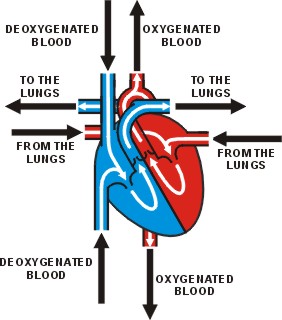A Heart to Heart About Your Health
by: Amy Westfall, ANP
In the fast-paced world we live in, it’s important to take the time to slow down and think about your health. February is American Heart Month, where the nationwide focus is all about heart health. The heart is one of the most important organs of the body, and it is important to take care of it! Every year, one out of four deaths is caused by heart disease (Heart Disease Facts). To understand heart disease, you need to understand how the heart works with the body.
The Heart
The heart’s main function is to pump blood throughout the body. However, the human heart is about the size of a fist. To get blood throughout the body, it must work efficiently. There are two pumping systems in the heart. The left half receives blood from the lungs, where it picks up oxygen. From that left half, blood with oxygen is then sent through the body. The right half receives blood coming from the body so that it can be sent back to the lungs to receive oxygen again (Michigan Medicine).

The Flow of Blood through the Heart https://www.cardionetics.co.uk/cardiology/the-heart/blood-flow/
Within each of the two pumping systems, the left side and right side, are two more sections, atriums and ventricles. The atriums receive the blood from the body, then push it to the ventricles, which push the blood out of the heart to the body (Encyclopedia Britannica).

Anatomy of the Heart https://www.britannica.com/science/heart
The blood is moved only when the heart muscle “beats”. This is when the heart contracts and expands quickly. This movement happens naturally through the body’s electrical system. The electrical system sends signals, or impulses through the body to where it needs to go (Michigan Medicine). The average adult’s heart beats sixty to one-hundred times per minute while at rest (Live Science).
Heart Disease
Heart disease is any condition that affects the heart. This can range from defects to heart attacks. Most heart conditions can be prevented by healthy lifestyle choices. Symptoms of heart disease differ depending on the affected area of the heart. Men and women may experience symptoms differently. For example, men are more likely to have chest pain. Women will typically have more shortness of breath, nausea and extreme tiredness (Mayo Clinic).
Symptoms of heart disease in the blood vessels:
- Chest pain, chest tightness, chest pressure and chest discomfort (angina)
- Shortness of breath
- Pain, numbness, weakness or coldness in your legs or arms if the blood vessels in those parts of your body are narrowed
- Pain in the neck, jaw, throat, upper abdomen or back
Symptoms of an abnormal heartbeat:
- Fluttering in your chest
- Racing heartbeat (tachycardia)
- Slow heartbeat (bradycardia)
- Chest pain or discomfort
- Shortness of breath
- Lightheadedness
- Dizziness
- Fainting (syncope) or near fainting
Symptoms of heart defects:
- Pale gray or blue skin color (cyanosis)
- Swelling in the legs, abdomen or areas around the eyes
- In an infant, shortness of breath during feedings, leading to poor weight gain
Symptoms of weak heart muscles:
- Breathlessness with action or at rest
- Swelling of the legs, ankles and feet
- Tiredness
- Irregular heartbeats that feel rapid, pounding or fluttering
- Dizziness, lightheadedness and fainting
Symptoms of heart infections:
- Fever
- Shortness of breath
- Weakness or tiredness
- Swelling in your legs or stomach
- Changes in your heart rhythm
- Dry or constant cough
- Skin rashes or unusual spots
Seek emergency medical care if you experience chest pain, shortness of breath and fainting. (Mayo Clinic).
Genetic Heart Conditions
Since the heart is so involved with the body overall, there are many illnesses and medical conditions that can affect heart health. Some heart conditions occur before birth. These are known as congenital heart defects. These defects happen when the heart or blood vessels near it do not develop correctly. Many different types of congenital heart defects can be diagnosed by a primary healthcare provider. Depending on the type and severity of the defect, treatment options may vary (American Heart Association).
Arrhythmia
Another heart condition is arrhythmia. This happens when a person’s natural heartbeat is not following a normal pattern. The heartbeats may be happening too fast, too slow or irregularly. Like defects, there are multiple types of arrhythmias; speaking with your provider can help determine treatment options (American Heart Association).
High blood pressure
Another condition half of American adults suffer from is high blood pressure (American Heart Association). This means that the flow of blood creates too much pressure on the blood vessels. To be diagnosed with high blood pressure, it must regularly be high pressure. When you see your provider, they will always check your blood pressure.

Blood Pressure Numbers and their Meanings https://www.heart.org/en/health-topics/high-blood-pressure/the-facts-about-high-blood-pressure
High blood pressure does not have visible symptoms. A person’s risk of having high blood pressure can be increased by poor lifestyle choices. Left untreated, it can cause permanent damage to the heart and blood vessels. Often, this damage can lead to more serious problems like strokes and heart attacks (American Heart Association).
Cholesterol
Levels of cholesterol are another factor that affects the heart. Cholesterol is a waxy substance that is made by the liver and is a necessary building block for cells. Sometimes, foods that are high in saturated fat and trans-fat can cause the liver to make more cholesterol. If foods high in fat are eaten regularly, it can cause an unhealthy amount of cholesterol.
There are two types of cholesterol: LDL and HDL. LDL is considered bad, while HDL is good. When there is too much LDL and very little HDL, the cholesterol will begin to build up in the major arteries to the heart and brain. This can lead to heart attack and stroke if a blood clot forms and blocks the already narrow arteries (American Heart Association).
Risk Factors
Many risk factors of heart disease are caused by poor lifestyle choices. Lifestyle choices are habits and routines that impact our health. Some poor lifestyle choices include smoking, excessive use of alcohol and drugs, and poor diet. By choosing to eat healthy and exercise regularly, a person’s risk of heart disease is much lower. Some risk factors, such as age, gender and family history are out of a person’s control, but they can all affect a person’s risk of heart disease. For example, aging increases the risk of heart disease due to weak or damaged arteries and blood vessels. While some risk factors are not able to be controlled, there are steps people can take to reduce the possibility of heart disease (Mayo Clinic).
Preventative Care
Preventing heart disease takes time and patience. Changing your diet to include more healthy choices can make a huge difference in your heart health. Regular exercise is also important. Ease into regular exercise by walking daily or a few times a week. This can make starting a healthy habit easier. Other ways to reduce the risk of heart disease is by quitting smoking and reducing or quitting alcohol and drug use. Another way to prevent heart disease is by going to see your healthcare provider annually, or more if necessary. By speaking to your provider about heart health concerns, they can provide you with resources to keep you healthy. If you are looking for a primary care provider, call AxessPointe today at 888-975-9188. For more information on AxessPointe visit axesspointe.org.
Center For Disease Control. (n.d.). Retrieved January 31, 2020. From https://www.cdc.gov/heartdisease/facts.htm
Michigan Medicine, University of Michigan. (2018, July 22). Retrieved January 31, 2020. From https://www.uofmhealth.org/health-library/tx4097abc
Cardionetics.(n.d.). Retrieved January 31, 2020. From https://www.cardionetics.co.uk/cardiology/the-heart/blood-flow/
Encyclopedia Britannica Heart Anatomy. (n.d.). Retrieved January 31, 2020. From https://www.britannica.com/science/heart
Live Science. What Is A Normal Heart Rate? (2018, January 12). Retrieved January 31, 2020. From https://www.livescience.com/42081-normal-heart-rate.html
American Heart Association. (n.d.). Retrieved January 31, 2020. From https://www.heart.org/en
Mayo Clinic. Heart Disease. (2018, March 22). Retrieved January 31, 2020. From https://www.mayoclinic.org/diseases-conditions/heart-disease/symptoms-causes/syc-20353118


